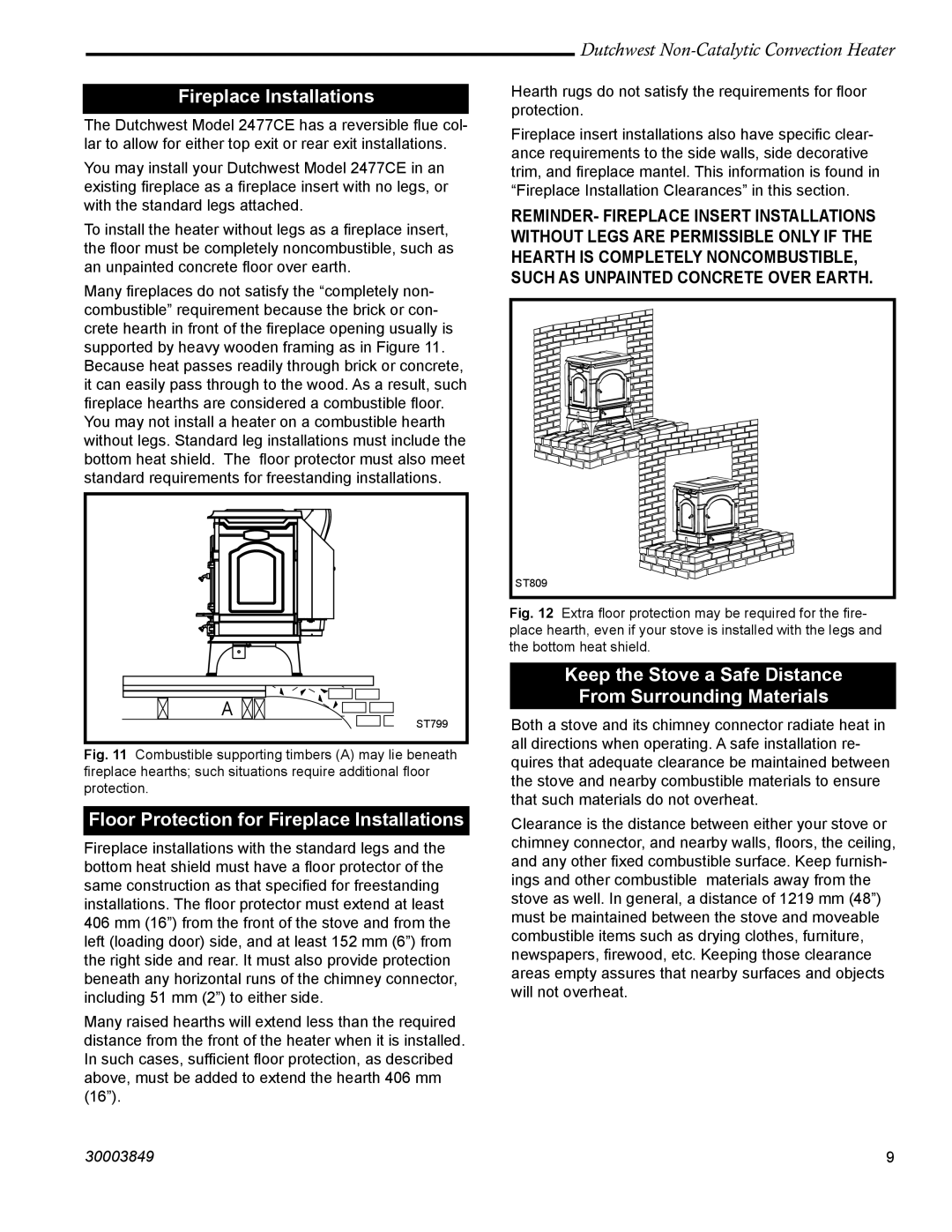
Fireplace Installations
The Dutchwest Model 2477CE has a reversible flue col- lar to allow for either top exit or rear exit installations.
You may install your Dutchwest Model 2477CE in an existing fireplace as a fireplace insert with no legs, or with the standard legs attached.
To install the heater without legs as a fireplace insert, the floor must be completely noncombustible, such as an unpainted concrete floor over earth.
Many fireplaces do not satisfy the “completely non- combustible” requirement because the brick or con- crete hearth in front of the fireplace opening usually is supported by heavy wooden framing as in Figure 11. Because heat passes readily through brick or concrete, it can easily pass through to the wood. As a result, such fireplace hearths are considered a combustible floor. You may not install a heater on a combustible hearth without legs. Standard leg installations must include the bottom heat shield. The floor protector must also meet standard requirements for freestanding installations.
A ![]()
![]()
![]()
![]()
![]()
ST799
Fig. 11 Combustible supporting timbers (A) may lie beneath fireplace hearths; such situations require additional floor protection.
Floor Protection for Fireplace Installations
Fireplace installations with the standard legs and the bottom heat shield must have a floor protector of the same construction as that specified for freestanding installations. The floor protector must extend at least 406 mm (16”) from the front of the stove and from the left (loading door) side, and at least 152 mm (6”) from the right side and rear. It must also provide protection beneath any horizontal runs of the chimney connector, including 51 mm (2”) to either side.
Many raised hearths will extend less than the required distance from the front of the heater when it is installed. In such cases, sufficient floor protection, as described above, must be added to extend the hearth 406 mm (16”).
Dutchwest
Hearth rugs do not satisfy the requirements for floor protection.
Fireplace insert installations also have specific clear- ance requirements to the side walls, side decorative trim, and fireplace mantel. This information is found in “Fireplace Installation Clearances” in this section.
REMINDER- FIREPLACE INSERT INSTALLATIONS WITHOUT LEGS ARE PERMISSIBLE ONLY IF THE HEARTH IS COMPLETELY NONCOMBUSTIBLE, SUCH AS UNPAINTED CONCRETE OVER EARTH.
ST809 |
Fig. 12 Extra floor protection may be required for the fire- place hearth, even if your stove is installed with the legs and the bottom heat shield.
Keep the Stove a Safe Distance
From Surrounding Materials
Both a stove and its chimney connector radiate heat in all directions when operating. A safe installation re- quires that adequate clearance be maintained between the stove and nearby combustible materials to ensure that such materials do not overheat.
Clearance is the distance between either your stove or chimney connector, and nearby walls, floors, the ceiling, and any other fixed combustible surface. Keep furnish- ings and other combustible materials away from the stove as well. In general, a distance of 1219 mm (48”) must be maintained between the stove and moveable combustible items such as drying clothes, furniture, newspapers, firewood, etc. Keeping those clearance areas empty assures that nearby surfaces and objects will not overheat.
30003849 | 9 |
